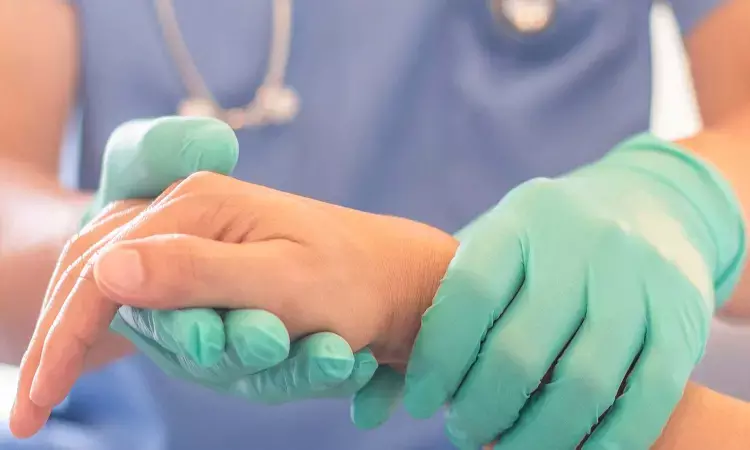- Home
- Medical news & Guidelines
- Anesthesiology
- Cardiology and CTVS
- Critical Care
- Dentistry
- Dermatology
- Diabetes and Endocrinology
- ENT
- Gastroenterology
- Medicine
- Nephrology
- Neurology
- Obstretics-Gynaecology
- Oncology
- Ophthalmology
- Orthopaedics
- Pediatrics-Neonatology
- Psychiatry
- Pulmonology
- Radiology
- Surgery
- Urology
- Laboratory Medicine
- Diet
- Nursing
- Paramedical
- Physiotherapy
- Health news
- Fact Check
- Bone Health Fact Check
- Brain Health Fact Check
- Cancer Related Fact Check
- Child Care Fact Check
- Dental and oral health fact check
- Diabetes and metabolic health fact check
- Diet and Nutrition Fact Check
- Eye and ENT Care Fact Check
- Fitness fact check
- Gut health fact check
- Heart health fact check
- Kidney health fact check
- Medical education fact check
- Men's health fact check
- Respiratory fact check
- Skin and hair care fact check
- Vaccine and Immunization fact check
- Women's health fact check
- AYUSH
- State News
- Andaman and Nicobar Islands
- Andhra Pradesh
- Arunachal Pradesh
- Assam
- Bihar
- Chandigarh
- Chattisgarh
- Dadra and Nagar Haveli
- Daman and Diu
- Delhi
- Goa
- Gujarat
- Haryana
- Himachal Pradesh
- Jammu & Kashmir
- Jharkhand
- Karnataka
- Kerala
- Ladakh
- Lakshadweep
- Madhya Pradesh
- Maharashtra
- Manipur
- Meghalaya
- Mizoram
- Nagaland
- Odisha
- Puducherry
- Punjab
- Rajasthan
- Sikkim
- Tamil Nadu
- Telangana
- Tripura
- Uttar Pradesh
- Uttrakhand
- West Bengal
- Medical Education
- Industry
AI driven TPNS Device Shows Promise for Treating Essential Tremor: JAMA

A new study published in the Journal of American Medical Association showed that the transcutaneous peripheral nerve stimulation device showed a substantial improvement in activities linked to upper limb tremor after 90 days, indicating that it might be a useful non-invasive therapy for essential tremor.
The most prevalent type of arm tremor is called essential tremor (ET). The central tremor-generating network can be modulated by transcutaneous peripheral nerve stimulation (TPNS). Thus, this study was set to determine if a TPNS device powered by artificial intelligence (AI) is more effective at lowering ET than a sham device.
From February 7 to August 9, 2024, 12 outpatient neurology clinics in China and the United States participated in a randomized clinical study. The adults with upper-extremity tremor who had been clinically diagnosed with ET were included. The participants had a total performance subscale score of at least 7, were familiar with using a smartphone and connecting to Wi-Fi at home, and had a tremor severity score of 2 or higher on one of the Essential Tremor Rating Assessment Scale (TETRAS) performance subscale tasks.
The subjects were classified by the severity of their tremors and the usage of ET medicines, and they were randomized 2:1 to receive either sham stimulation or active TPNS. The participants were told to utilize the gadgets during the day for 90 days after they were installed.
The main intervention consisted of a wearable neuromodulation device that stimulates the radial, median, and ulnar nerves and employs artificial intelligence to continually alter stimulation levels in real time. In the intention-to-treat population, the primary outcome was change in daily activities as measured by TETRAS's modified Activities of Daily Living (mADL) subscale at 90 days.
Out of the 133 people who were screened, 125 were randomly assigned to either TPNS (n = 83) or sham (n = 42) therapy. There were 62 (49.6%) females and 63 (50.4%) males, with a mean (SD) age of 64.9 (13.1) years and a mean (SD) duration of tremor of 11.4 (13.1) years. In the TPNS group, the mADL score decreased by 6.9 points (95% CI, 5.4-8.4) after 90 days, while in the sham group, it decreased by 2.7 points (95% CI, 1.3-4.0) (P <.001).
The most frequent adverse event linked to the device was skin irritation, which happened to 2 out of 42 participants (4.8%) in the sham group and 28 out of 83 participants (33.7%) in the TPNS group. One person in the TPNS group had nausea, arthralgia, exacerbation of pre-existing thumb arthritis, muscular weakness, and involuntary muscle spasms. Overall, at 90 days, the TPNS device enhanced upper limb tremor-related activities.
Source:
Ondo, W. G., Lv, W., Zhu, X., Hu, Y., Isaacson, S. H., Yuan, Y., Espay, A. J., Kreitzman, D., Kuo, S.-H., Brillman, S., Shill, H. A., Lyons, K. E., Yang, Z., Zhao, Q., Zhang, Z., & Pahwa, R. (2025). Transcutaneous peripheral nerve stimulation for essential tremor: A randomized clinical trial: A randomized clinical trial. JAMA Neurology. https://doi.org/10.1001/jamaneurol.2025.3905
Neuroscience Masters graduate
Jacinthlyn Sylvia, a Neuroscience Master's graduate from Chennai has worked extensively in deciphering the neurobiology of cognition and motor control in aging. She also has spread-out exposure to Neurosurgery from her Bachelor’s. She is currently involved in active Neuro-Oncology research. She is an upcoming neuroscientist with a fiery passion for writing. Her news cover at Medical Dialogues feature recent discoveries and updates from the healthcare and biomedical research fields. She can be reached at editorial@medicaldialogues.in
Dr Kamal Kant Kohli-MBBS, DTCD- a chest specialist with more than 30 years of practice and a flair for writing clinical articles, Dr Kamal Kant Kohli joined Medical Dialogues as a Chief Editor of Medical News. Besides writing articles, as an editor, he proofreads and verifies all the medical content published on Medical Dialogues including those coming from journals, studies,medical conferences,guidelines etc. Email: drkohli@medicaldialogues.in. Contact no. 011-43720751


